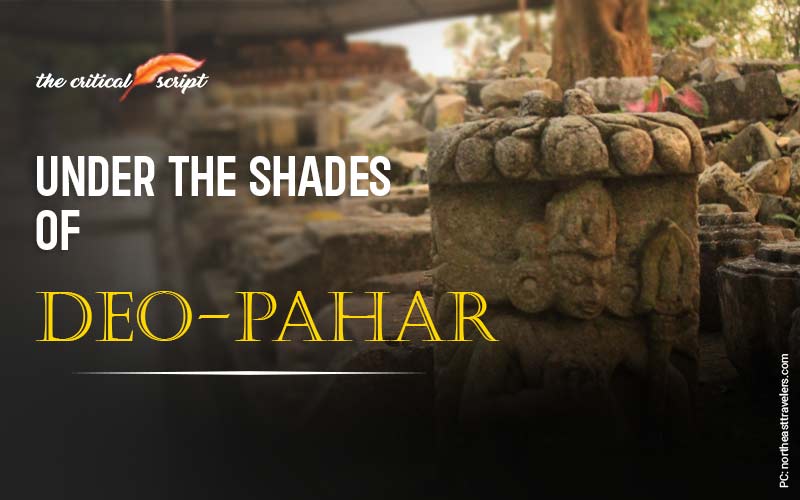
Under the Shades of Deo-Pahar
Fig 1: Flying Vidyadharas of Deo-Pahar
Deo-Pahar is an important visiting point with a lot of historical value situated in Golaghat district of Assam. The name Deo-Pahar refers itself about it- the hill of divine beings- hill of flying Vidyadharas, celestial musicians, epics and gods. Some contexts also refer it as Jarashndha Parvat. According ‘Ahomar Din’ by Hiteshwar Barbaruah the name Deo-Pahar was given by the Ahoms due to a fantastic incident. Once Ahom king Su-hung-mung decided to build a rampart on the boarders of Naga hills. When paiks were building the rampart, they found a huge human like being under the soil. The paiks informed the king about it. They described it as a huge being nearly equals to an elephant. The king ordered the work to stop. From that incident that place was known as Deo-Pahar. The Deo-Pahar sculptures strongly point to a great era of history about which we don’t have much knowledge. Time wiped it out with such cruelty. We don’t know abjectly what happened to those people who had such a great knowledge of architecture. We don’t have any clear historical evidence.
By 1826 British rule established in Assam. They started tea gardens on lands and hills of Assam. Thick forests were cleared for establishing tea gardens, new roads were made, railway lines were constructed. And eventually somehow, under the thick forests of Numaligarh they found Deo-Pahar architectures. The person who said to be found Deo-Pahar was British topographer, surveyor, geologist H.H. Godwin Austen who even had a glacier named after him.
Historical evidence says that Deo-Pahar architecture was a creation of a rich cultured civilization on the bank of river Dhonshiri. A civilization nourished by the rivers Doi-yang and Dhonshiri. Ancient folklores tell us that once Doi-yang was attracted by Dhonshiri’s beauty and he wanted to marry her. But she refused his proposal and flowed in a spiral path avoiding Doi-yang. But Doi-yang did not lose hope and always tried to flow besides her. So, those rivers have many curves in their path. Geologists called this process meandering. Most rivers on the south bank of Brahmaputra are meandering rivers. The reason of Dhonshiri’s meandering is active Dhonshiri fault. It is a line where ancient stones were suppressed at least 4-5 km underground. These stones were once used to be a part of Burha Pahar. This active line is spread to Himalayas.
These two rivers created a healthy environment to establish a civilization in this valley. Nature formed this land so perfectly from a strategic point of view that it was an important and powerful strategic point for many kingdoms. The rivers were natural defenders for the valley. Many water forts and man-made harbors founded in this area indicates that once it was an important place not only for strategic point of view but also for economic point of view. Another importance of this valley was that they had access to an important element- Iron. Slag heaps and iron smelting sites founded in this region indicates that they had a very good knowledge of iron works.
But who were the controllers of this water forts and harbors? Stone inscriptions and clay seal founded in this region tell us about some historical figures like Ratnavarman, Vasundharavarmana who ruled this region between 4th and 5th century AD. The title ‘Varman’ shows their connections with the Varman dynasty of Kamarupa. That mighty Varman dynasty who referred themselves as successors of Naraka, the son of Varaha Vishnu. But there is a fact that the abovementioned figures were nowhere to be found in any of the ancestries of the Varman royal houses. Possibilities are that they maybe belong to a collateral branch of the Varmans. Or maybe titles like Varman, Pala etc. are used to identify someone as Kshatriya, as this titles were found in some other dynasties also. One noticeable point is that the Deo-Pahar architectural remains are much skillful than other sculptures found in Doi-yang Dhonshiri region.
They have a high degree of perfection and a sign of a highly developed architect community. So, there is a doubt that if it was constructed during the same kingdom as of the other architectures of Doi-yang Dhonshiri valley. There is even an assumption that maybe Deo-Pahar architecture was a creation of later Salastambhas. Now a days Deo-Pahar archeological site is only a collection of broken sculptures and remaining stone pieces. It reminds us of a gorgeous temple structure with a high degree of perfection. According to some historians It was maybe constructed in Nagara style. The stones used on the temple are sand stones, might be carried here from Naga hills through the river Dhonshiri. The stones were connected with each other with the help of melted iron. It was a shiva temple. The main lingam of the temple was said to be transferred to the nearby Baba Than in Numaligarh Tea estate by a brahmin named Narayan Kandali. But Baba Than temple is not much old, roughly between 100-150 years. The Deo-Pahar remains not only indicate the highly precise architectural work of that time but also lights on the social life of that time. They tell us about music, dance, fashion, weapons and many more. The main attraction of the site is a giant foundation with gracious flying Vidyadharas1 (Fig:1) holding lotus buds with both hands. Above the Vidyadharas there is a layer of elephants facing outward. A major part of a celling can be noticed falling on ground. It contains a beautiful lotus sculpture with three layers of concentric petals. It is termed as ‘Viswapadma’. The huge foundation is said to be the seed vessel of Viswapadma. Some other sculptures founded here are from episodes of Mahabharata and Ramayana, Yama, Agni, mythical lions, Kirti Mukha2, kalamakara, mythical birds, intimating couples etc.
The Kirti Mukhas of Deo-Pahar has many distinctive features. They are not similar with Kirti Mukha sculptures of other South-east Asian regions. Even many key differences can be seen between those and other Kriti Mukha sculptures founded in Assam. It’s maybe due to the reason that Deo-Pahar art style was a completely different art style with many unique features. The unique features can be seen in Kalamakara and Lion sculptures also. There are two lion sculptures that caught our eyes on Deo-Pahar. It should be remembered that the lion was never a native animal of this region. And like most parts of South-east Asia those line sculptures have many dragon-like features. One of them looks quite 2d with long neck and has less artistic features (fig:5 left) and the other is more 3d, looks more lively, has more artistic feature (fig:5 right).
Maybe the temple was not completed by only one group of artists but generations of artists. Clearly the temple took a long period to be built and it was not possible by one group of artists. Different group of artists give it different features. Possibilities are not zero. One of the noticeable things in the Deo-Pahar sculptures is the fashion of that time. The clothes of the figures, headgears, jewelries are pretty impressive. We can see upward boat-shaped moustache on male figures (fig:7). Was it a fashion of that time? Same type of moustaches can be found on the sculptures of Kamakhya temple also. Is this an indication of cultural exchange? Deo-Pahar architect style and Kamakhya architect style don’t have artistic resembles with each other, but such points indicate they must have cultural exchanges. Maybe due to the lineage connection with Kamarupa!
The curved stone panels of Deo-Pahar have a wide source of information of their time. we can consider them as comic or Puthi-Chitra of that time. The stone panels mainly contain episodes of Mahabharata and Ramayana with many local features. Some of them show local traditions, dance forms and musical instruments of that time. And it is not surprising that some of them even exist in later culture and traditions (fig:8,9). Great art always inspires later artisans. And it is the process through which the soul of a land survives from generation to generations throughout the history.
We don’t have clear information about when and how this mesmerizing temple structure fell down. Most evidence points to a great earthquake. Assam was never a stable land politically or geographically. Records of many great earthquakes can be found in Ahom Buranjis. One or two of them might collapsed it completely. But when? Does the later Kocharis and Ahoms know about that temple? Earlier we had discussed about the context of Ahom Buranji about this place. What was that giant creature? Was it actually a giant Kirti Mukha sculpture which can be seen there even today? Well, the writer does not claim about the truth of this assumption. It’s only an assumption.
The Buranjis had many information about this region but not about the temple. Maybe the temple was deformed much earlier. So, ignorance of people hid it completely. Worship in a deformed temple was out of rule.
The Doi-yang Dhonshiri valley was an important region even for the later periods. As we said earlier, it was a strategically very important region. The Kocharis built many brick ramparts here. For Ahoms it was a very important region for protection against Bangals. After the invasion of Mir-Jumla they created a huge defense mechanism here. Because if the Bangals would attack the kingdom it was the only second safe place to resist them after Guwahati. Ahoms had many iron furnaces in this region from where bullets and other weapons were supplied for wars. Iron work was practiced in this region till the end of the Ahom dynasty. During the British raj in Assam the Marwari merchants started business here on the banks of the rivers due to which the entire region became known as Golaghat. Unknowingly, this merchant woke up the soul of ancient busy harbors again. History repeats its imprints. And that’s why history is quite interesting.
History is not only a lifeless collection of past incidents at all. It lives somewhere between us without our concern. We human are ourselves a creation of our history. It is an endless flow across time, across generations. Knowing history is knowing ourselves, politically, culturally, geographically and even psychologically. At last, we would like to say, history is not something only about kings and kingdoms but also about art, culture, society, nature and much more. And specially, it is about common people who leads the society to the future. Kingdoms may vanish, kingship may collapse but those are common people who preserves the ideas and knowledge and pass down it to their descendants. So, the soul of a land never dies; whatever the kingdom ruled over it, Varmans or Kocharis or Ahoms or whatever.
Special thanks to:
Abantika Parashar, district Museum Officer, District Museum, Jorhat.
Bashab Nandan Mahanta, Director, Geological Survey of India.
Bikash Dihingiya, Asst. teacher, 73 no. Dulia Gaon L.P. School.
External Sources:
Ahomar Din, Hiteswar Borboruah, 2nd Edition
Photo Courtesy
Mousum Gogoi, Author.
Bhuban Muhan Dutta, Golaghat.
Fig 10: Jatayu resisting Ravana, Deo-Pahar sculpture.
Fig 11: Bakasur badh, Chitra-Bhagawat
Article Contributed by Mousum Gogoi
Disclaimer: The opinions expressed in this article are those of the author's. They do not purport to reflect the opinions or views of The Critical Script or its editor.

Newsletter!!!
Subscribe to our weekly Newsletter and stay tuned.



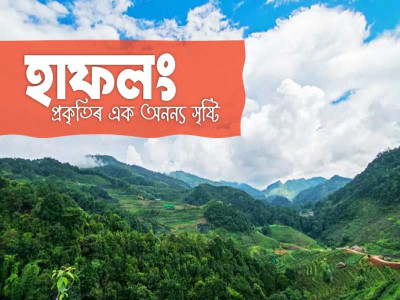
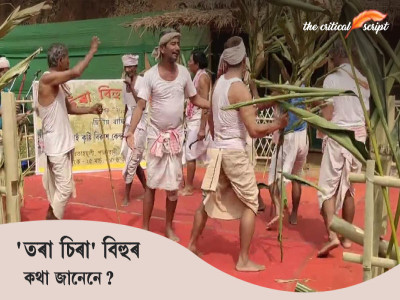
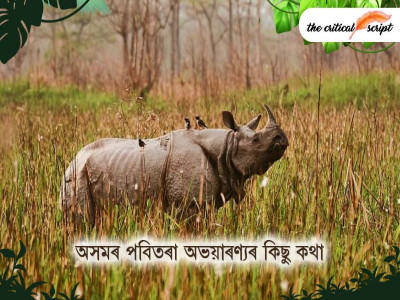
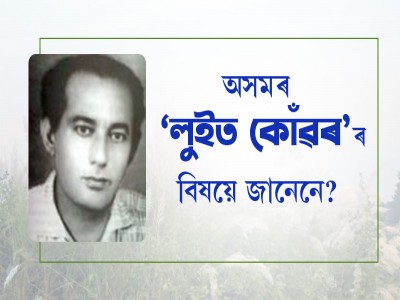
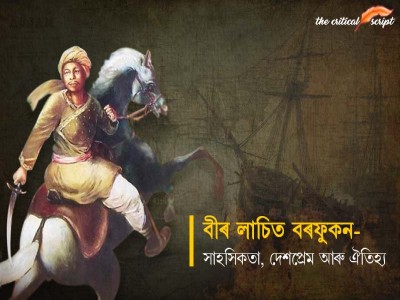
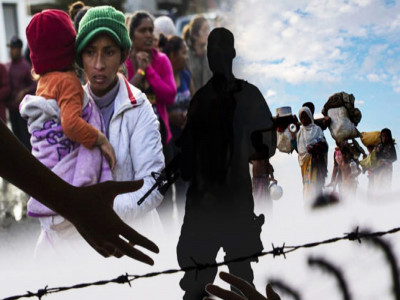

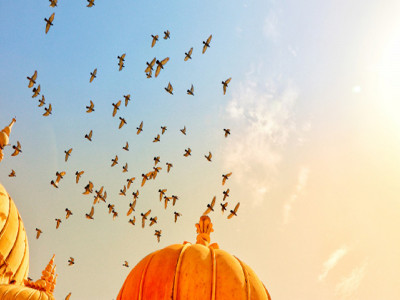
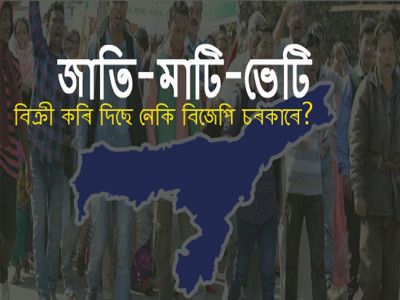





Related Comments